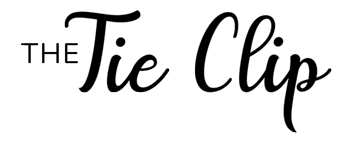Ties
How To Wear a Tie Clip/Bar/Tack: Guide For Beginners
Upgrade your style with the simple elegance of a tie clip. It keeps your tie in place while adding a polished touch to your outfit. This beginner’s guide from TheTieClip shows you how to wear it right for both style and function. Whether it’s your first time or you’re refining your look, this guide makes it easy to master this timeless accessory.
1. How to Choose the Right Tie Clip, Bar, or Tack
A tie clip, bar, or tack is a simple accessory that adds style and function to your outfit. Follow these steps to find the perfect one:
- Match the Width: Choose a clip that’s 60-75% the width of your tie. Anything too wide or too narrow throws off the look.
- Choose the Material: Stick with popular materials like stainless steel, silver, or gold. Match it with your watch or cufflinks for a polished appearance.
- Pick the Right Design: Formal events call for minimalist designs like smooth metal bars. For casual wear, explore textured styles, engraved details, or unique shapes.
- Select the Color: Neutral colors like silver, black, or gold work well with most ties. For a bold touch, go for clips with enamel accents or interesting patterns.
- Decide on the Type
- Tie Clips/Slide Bars: Perfect for lightweight ties and a modern look.
- Tie Tacks: Great for vintage styles but can damage tie fabric if not used carefully.
- Hinged Clips: Best for thicker ties, providing a secure hold.
The right tie clip, bar, or tack adds balance and elegance to your outfit with minimal effort.
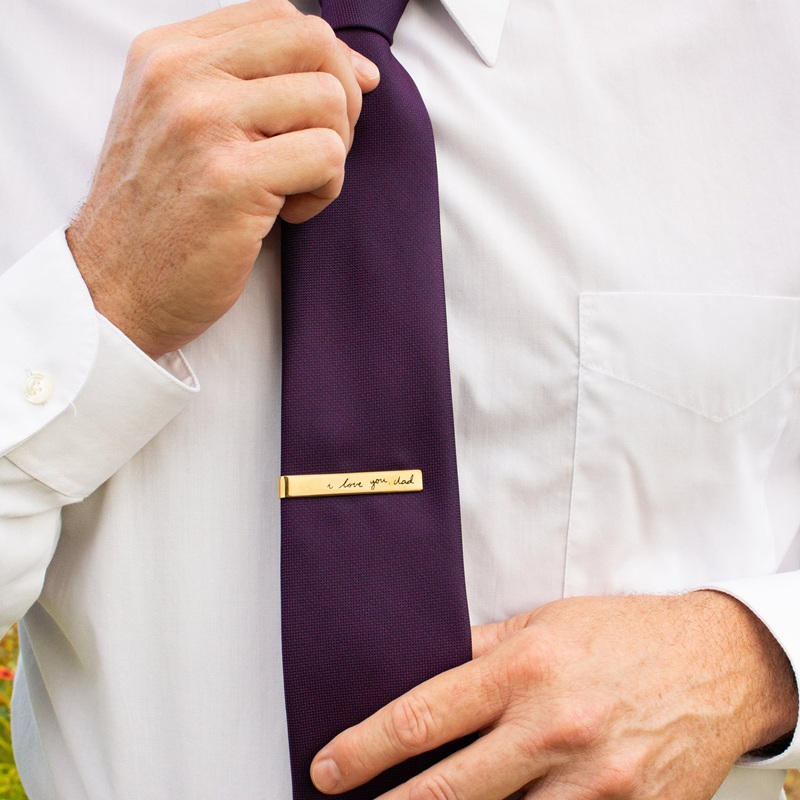
2. Step-by-Step Guide to Wearing a Tie Clip, Bar, or Tack
Wearing a tie clip, bar, or tack properly enhances your style and keeps your tie secure. Follow these simple steps:
2.1. Position the Tie Clip
Place the tie clip between the third and fourth buttons of your shirt. This keeps your look balanced and polished.
2.2. Align the Tie
Straighten your tie so the front and back layers overlap neatly. The tie clip should hold both layers against your shirt.
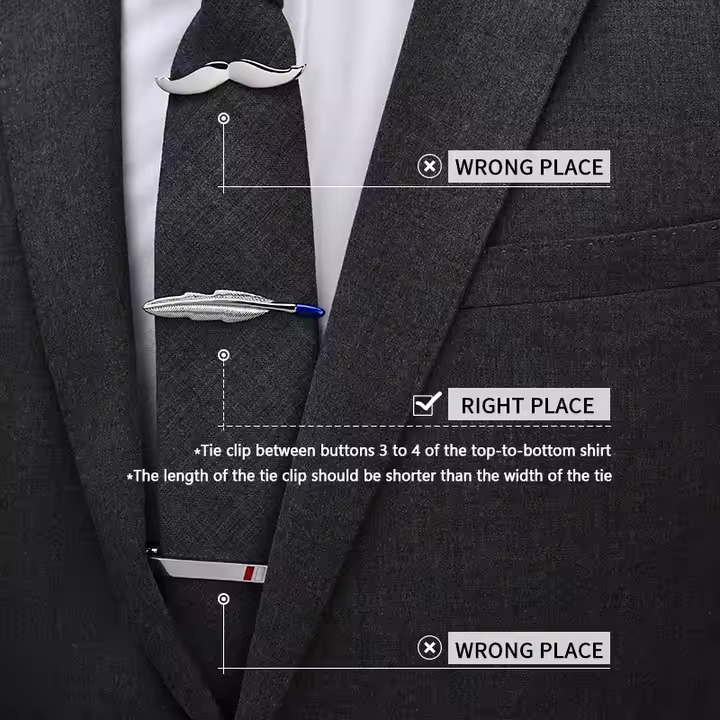
2.3. Attach the Clip or Tack
- Tie Clip or Bar: Slide it horizontally across the tie and fasten it to your shirt.
- Tie Tack: Gently pierce the tie and secure the backing to your shirt.
2.4. Keep It Straight
Ensure the tie clip sits perfectly horizontal. Avoid angling it to maintain a clean, professional look.
2.5. Test the Fit
Gently tug the tie to ensure the clip holds it firmly without damaging the fabric.
2.6. Match Your Outfit
Choose a tie clip that complements your accessories, like cufflinks or a watch. Stick to colors and finishes that enhance your ensemble.
By following these steps, you’ll effortlessly combine style and practicality with this timeless accessory.
3. Common Mistakes to Avoid When Wearing a Tie Clip
A tie clip is a small detail that makes a big difference—when worn properly. Avoid these common missteps:
- Placing It Incorrectly: Position the tie clip between the third and fourth buttons of your shirt. Too high or too low looks awkward and disrupts your outfit’s balance.
- Not Securing It to the Shirt: Always fasten the tie clip to your shirt placket. Clipping it to the tie alone won’t keep it in place and defeats its purpose.
- Ignoring Proportions: The tie clip’s width should match your tie. Aim for 60-75% of the tie’s width. Oversized clips look bulky, while tiny ones seem out of place.
- Angling the Tie Clip: Keep the tie clip horizontal. A tilted clip looks careless and unpolished.
- Over-Accessorizing: Keep it simple. Avoid combining bold tie clips with loud cufflinks, patterned ties, or flashy pocket squares. Too much stands out for the wrong reasons.
- Choosing the Wrong Style: Match the tie clip to the occasion. A sleek metal bar works for formal events, while textured or colorful designs fit casual settings.
- Using It on the Wrong Tie: Don’t pair tie clips with wide or knit ties. These styles don’t hold well and clash with the clip’s purpose.
By avoiding these mistakes, you’ll wear a tie clip that enhances your look with effortless style.
4. Matching the Tie Clip with Other Accessories
4.1. Matching with cufflinks, watch, and belt buckle
A tie clip does more than keep your tie in place—it elevates your outfit. Aligning it with your cufflinks, watch, and belt buckle ensures a cohesive, polished style.
4.1.1. Cufflinks
- Match the Metal: Pair silver cufflinks with a silver tie clip, or gold with gold, to anchor your look. Consistency in metal tones keeps your outfit unified.
- Coordinate Designs: Choose a tie clip that mirrors your cufflinks’ details. Sleek cufflinks pair best with a minimalist clip, while textured or engraved designs can echo more intricate accessories.
- Try Subtle Contrast: Add interest by mixing finishes. Pair matte tie clips with polished cufflinks, but stick to the same metal tone for balance.
4.1.2. Watch
- Align the Case: Match the tie clip’s metal to your watch case. A stainless steel or silver watch calls for a silver clip, while gold watches work with gold clips.
- Consider the Strap: Coordinate with your watch strap. If it’s leather, match the clip to the strap’s buckle or tone for a seamless look.
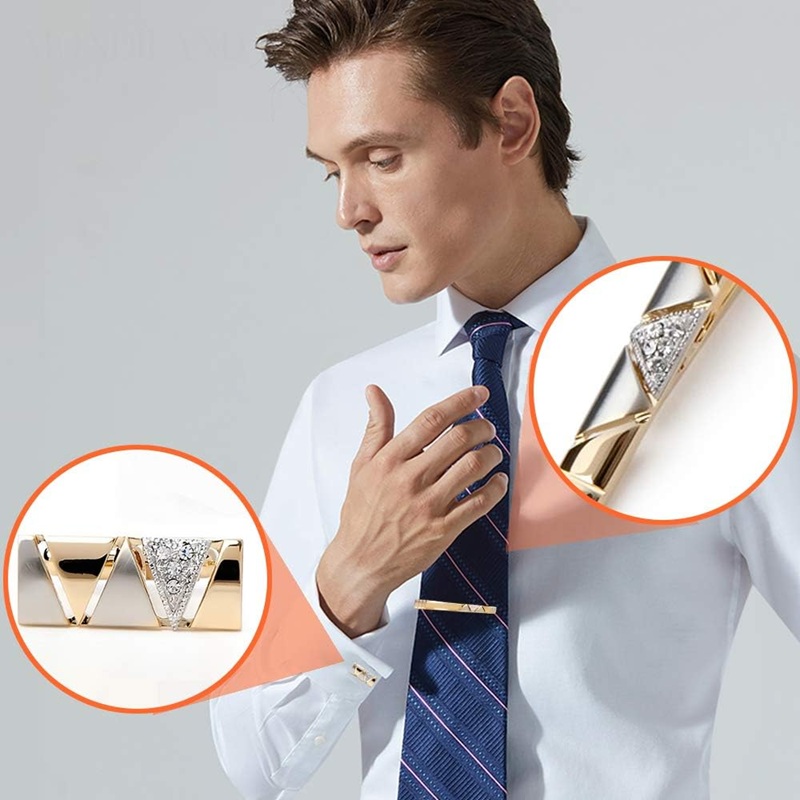
4.1.3. Belt Buckle
- Match the Finish: Your tie clip should match the buckle’s metal and finish. A shiny silver buckle pairs with a polished silver clip, while a matte black buckle suits a minimalist black clip.
- Stay Consistent: For formal occasions, stick to sleek and simple designs. Reserve textured or playful clips for casual or semi-formal events.
4.1.4. Why It Matters
Details make the difference. Matching your tie clip with these key accessories shows thoughtfulness and elevates your style. Whether for a boardroom meeting, a wedding, or a casual gathering, this simple coordination ensures your outfit feels intentional and refined.
4.2. Coordinating with tie color and pattern
A tie clip does more than secure your tie—it adds style. By aligning it with your tie’s color and pattern, you create a cohesive, polished look.
4.2.1. Matching with Tie Color
- Neutral Options: Silver, gold, and black tie clips are classic choices that work with almost any tie color, making them perfect for both formal and casual occasions.
- Tone-on-Tone: Match the clip with a shade in your tie for a seamless and refined appearance. For instance, pair a silver clip with navy or charcoal ties and a gold clip with burgundy or olive tones.
- Contrasting Pop: Use contrast to add flair. A silver clip shines against dark ties like black or forest green, while black or gunmetal clips create depth against lighter pastel shades.
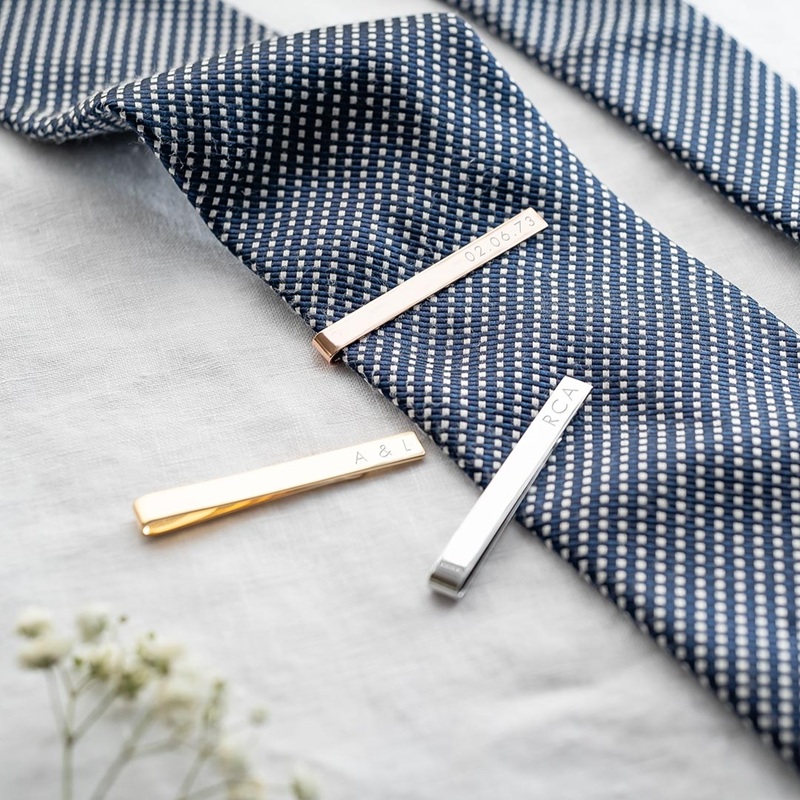
4.2.2. Matching with Tie Pattern
- Solid Ties: Solid-colored ties pair well with any clip style. Use textured or brushed clips to add subtle interest to the look.
- Striped Ties: Match the clip’s tone with the stripe’s colors. A simple, sleek clip balances bold or diagonal stripes without overpowering them.
- Patterned Ties: For ties with paisley, floral, or geometric patterns, stick to minimalist clips in neutral shades to avoid clashing. Let the tie’s design stand out.
- Textured Ties: For knitted or woven ties, choose matte or brushed-finish clips that enhance the tie’s texture and provide a secure grip.
4.2.3. Why It Matters
Coordinating your tie clip with your tie’s color and pattern reflects attention to detail and sophistication. This balance elevates your outfit, leaving a lasting impression with minimal effort.
5. Wearing Tie Clips with Different Tie Styles
5.1. Skinny ties, standard-width ties, knit ties, etc.
Your tie choice affects the size, style, and placement of your tie clip. Pairing the right clip with the tie—skinny, standard-width, knit, wide, or textured—keeps the look sharp and functional. Here’s how to match them effectively:
5.1.1. Skinny Ties
• Keep It Proportional: Choose a short clip that covers 60–70% of the tie’s width. It maintains the sleek look.
• Modern Style: Opt for matte or brushed finishes to complement the slim, contemporary design.
• Smart Placement: Position the clip lower, near the fourth shirt button, for balance with the tie’s narrow shape.
5.1.2. Standard-Width Ties
• Balanced Clips: Pick a clip covering 60–75% of the tie’s width. It adds harmony without overpowering the tie.
• Versatile Choices: Use polished metal clips for formal settings. For casual looks, go for textured or colorful styles.
• Classic Appeal: These ties work well with timeless designs that suit many outfits.
5.1.3. Knit Ties
• Firm Hold: A strong clasp is essential to secure the textured material.
• Relaxed Placement: Place the clip mid-chest, near the third or fourth button, for both function and style.
• Simple Elegance: Matte or brushed finishes match the casual texture without looking too flashy.
5.1.4. Wide Ties
• Proportional Length: Use a longer clip covering 60–75% of the tie’s width for a balanced look.
• Bold Designs: Wide ties suit standout clips with patterns, textures, or unique finishes.
• Retro Vibes: Perfect for vintage-inspired or bold ensembles.
5.1.5. Textured or Patterned Ties
• Subtle Touch: Neutral, simple clips work best to avoid clashing with intricate patterns or textures.
• Support the Tie: Let the clip enhance the overall design without stealing attention.
5.1.6. Why Pairing Matters
The right tie clip shows attention to detail and elevates your outfit. Whether for business, formal events, or casual outings, matching your clip to the tie creates a polished, intentional look. It balances style and functionality, adding a touch of refinement.
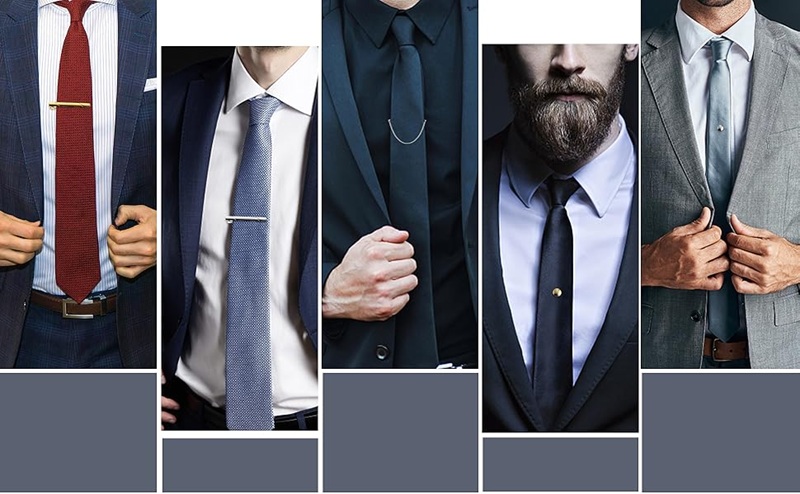
5.2. Can a tie clip be worn with a bowtie or ascot?
Tie clips are classic accessories for neckties but rarely work with bow ties or ascots. Here’s why—and how to enhance these styles with the right accessories:
5.2.1. Bow Ties
• Why Not a Tie Clip? Bow ties, whether pre-tied or self-tied, stay in place on their own. A tie clip would disrupt their neat, polished look and seem unnecessary.
• Better Alternatives: Pair a bow tie with a pocket square, cufflinks, or lapel pin. These add elegance without clashing with the bow tie’s clean style.
5.2.2. Ascots
• Why Not a Tie Clip? Ascots are loose and flowing, either tucked into a shirt or draped across the chest. A tie clip would interfere with their relaxed, layered appearance.
• Better Alternatives: Use a scarf ring, stick pin, or ascot pin to secure the fabric if needed. A subtle brooch or lapel pin can also complement the ascot’s elegant look.
5.2.3. Key Takeaway
Tie clips work well with neckties but not with bow ties or ascots. For these styles, choose accessories that enhance their unique design. Thoughtful choices keep your outfit stylish, cohesive, and appropriate for the occasion.
6. When and Where to Wear Tie Clips, Bars, or Tacks
Tie clips, bars, and tacks are small accessories that add style and practicality to your outfit. Knowing when to wear them ensures they enhance your look without overwhelming it.
6.1. Formal Occasions
Tie clips shine at formal events like weddings, black-tie galas, and corporate ceremonies. A simple metal bar in silver or gold complements classic ties and tailored suits. Pair it with a polished outfit for an elegant touch.
6.2. Professional Settings
In business settings, a tie clip keeps your tie secure while adding a refined touch. Choose subtle, minimalist designs that align with office norms, like smooth silver or matte black. Avoid bold or ornate styles that might distract from your professional image.
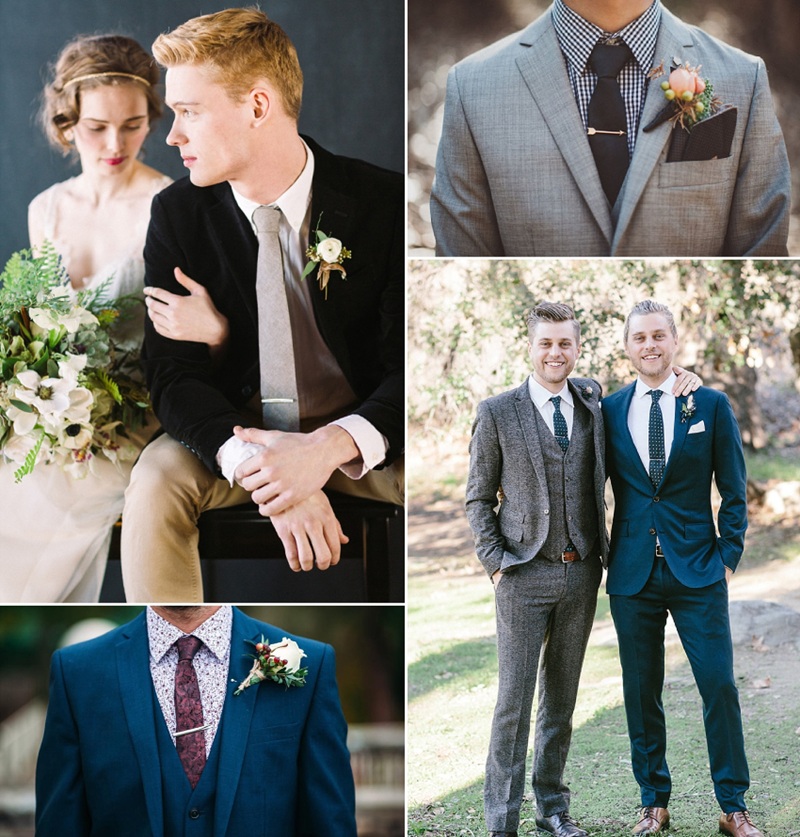
6.3. Casual Events
For casual gatherings like dinners or networking events, tie clips let you express your personality. Opt for textured finishes, playful shapes, or pops of color. Make sure the clip suits the laid-back vibe of the occasion and pairs well with your outfit.
6.4. Outdoor or Active Situations
When attending outdoor events or engaging in activities, a tie clip is a practical choice. It keeps your tie in place, preventing it from flapping or looking untidy. This makes it ideal for weddings, corporate mixers, or other events involving movement.
6.5. When Not to Use a Tie Clip
Some situations call for skipping the tie clip:
- With Bow Ties: Bow ties don’t require clips, as their design eliminates the need for one.
- With Knitted or Wide Ties: These styles don’t work well with clips due to their texture or size.
Wearing a tie clip at the right time and with the right outfit elevates your look effortlessly. It’s a small detail that combines style and function perfectly.
Conclusion
A tie clip is more than just a practical accessory—it’s a timeless symbol of elegance that elevates your outfit. Whether you’re attending a wedding, leading a meeting, or enjoying a casual evening, the right tie clip secures your tie and adds a polished finish.
This guide from TheTieClip simplifies the process. Remember these key points:
- Choose the Right Clip: Match the size, material, and design to your tie and outfit. Aim for a clip that spans 60–75% of your tie’s width.
- Position It Correctly: Place your tie clip between the third and fourth buttons of your shirt for a sharp, balanced look.
- Coordinate Accessories: Align your tie clip with your cufflinks, watch, and belt buckle for a unified style.
- Know When to Skip It: Avoid using tie clips with bow ties, ascots, or wide, heavily textured ties, as these styles aren’t suited for clips.
With these simple tips, you’ll master this timeless accessory, showcasing your personal style with ease.
Shop now at TheTieClip and discover our collection of classic and modern designs. A tie clip is a small detail that makes a big difference—elevate your wardrobe today!
